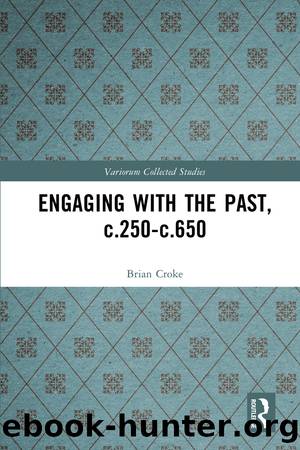Engaging with the Past, C.250-c.650 by Brian Croke;

Author:Brian Croke;
Language: eng
Format: epub
Publisher: Taylor & Francis (Unlimited)
Published: 2023-06-15T00:00:00+00:00
Reading and writing history under Christian kings, 500â600
At Rome under Gothic rule in the 530s, Cassiodorus had unsuccessfully sought to raise funds to establish a Christian school of higher learning, like the one he had heard about in faraway Nisibis. By the 560s, with imperial authority restored in Italy, Cassiodorus had returned from Constantinople with a fuller knowledge of the Nisibis school. He was now settled in a monastery at coastal Vivarium, where he supported the education of his monks by compiling the Institutes, a guide to Christian literature in Latin, including history. It consisted of Josephusâ Antiquities of the Jews, which he had translated, and his Jewish War, which formed a prelude to the church history of Eusebius. Both works had been translated by Rufinus, and the latter was continued by him. Reading these books, so Cassiodorus assured his monks, illustrates that the pagans were wrong. History is guided by the will of the Creator. Cassiodorus then goes on to recommend the church histories of Socrates, Sozomen and Theodoret, which he had arranged to be combined and translated by Epiphanius as the so-called Historia Tripartita, along with Orosius who brought together Christian and pagan times. In addition, there were the chronicles of Eusebius, translated and continued by Jerome, followed by those of Marcellinus and Prosper and their unspecified continuators (Institutes 1. 17.1â2). Cassiodorus will have known Maximian, bishop of Ravenna, but he does not cite Maximianâs lost chronicle (Agnellus, Liber Pontificalis 78), which may be partly preserved in the Excerpta Valesiana.
By the 6th century, imperial authority no longer extended to Gaul and Britain, Spain and Ireland, but the Cassiodoran historiographical model could now be found there. Reading and writing history was still the preserve of the best educated, but the best educated were now mainly bishops and monks, so classical rhetoric was de-emphasised.100 In Gaul, Gregory, the bishop of Tours, wrote a history in ten books covering the period from Adam to 594, focussed on the period after the death of King Sigibert in 575, and which was linked into a Christian chronology.101 Regularly resorting to oral sources, his history of kings and bishops was written for officials of the court of the Frankish king as well as local clergy at Clermont and Tours, and was influenced by Gregoryâs need to deal with local apocalyptic concerns. Gregory was placing himself in the same tradition as Rufinus and Orosius, whom he used extensively. Meanwhile, the equally educated Marius, bishop of Avenches, chose the chronicle format to tell the story from 455 (end of Prosper) to the 580s.102 In Britain, the monk Gildas, although probably educated in Gaul, was able to acquire sufficient grammatical and rhetorical education to become familiar not only with Vergil but also Jerome, Sulpicius Severus, Rufinus and Orosius, as displayed in his de excidio Brittonum, in which he set out to persuade his educated audience of the shortcomings of their rulers.103
100 Brown (2003), 235. 101 Goffart (1988), 112â234; Heinzelmann (2001); Halsall (2007). 102 Favrod (1993). 103 Croke (2003), 375â81.
Download
This site does not store any files on its server. We only index and link to content provided by other sites. Please contact the content providers to delete copyright contents if any and email us, we'll remove relevant links or contents immediately.
Patriot by Alexei Navalny(348)
Museum of Antiquity by T. L. (Thomas Louis) Haines(286)
The Story of Joan of Arc by Andrew Lang(272)
2,2-Dimethyl-3,4-dihydro-2H-1,4-benzoxazines as isosteres of 2,2-dimethylchromans acting as inhibitors of insulin release and vascular smooth muscle relaxants by Bernard Pirotte & Xavier Florence & Eric Goffin & Philippe Lebrun(253)
The Apollo Moon Missions by Randy Walsh(243)
Richard III and the Princes in the Tower by A.J. Pollard(240)
The Memoirs of Pere Labat, 1693-1705 by Jean Baptiste(239)
Fry The Brain: The Art of Urban Sniping and its Role in Modern Guerrilla Warfare by John West(205)
A History of the Peninsular War, Vol. 5, Oct. 1811-Aug. 31, 1812 by Charles Oman(188)
The Memoirs of Count Grammont â Complete by Hamilton Anthony Count Walter Scott(183)
1916 - The Battle of the Five Empires: 15 May - 28 September 1916 by Benoît Chenu(181)
Life of Napoleon Bonaparte, Volume I. by Walter Scott(181)
Maleficium: Witchcraft and Witch Hunting in the West by Gordon Napier(175)
Rasputin the Rascal Monk by William Le Queux(171)
Famous Fights of Indian Native Regiments by Reginald Hodder(167)
BY MARK Twain, Twain - The innocents at home by 1881(156)
Father Browne's Titanic Album by E. E. O'Donnell(155)
The Thoughts of Marcus Aurelius by Marcus Aurelius(152)
Joanna of Flanders by Julie Sarpy(140)
